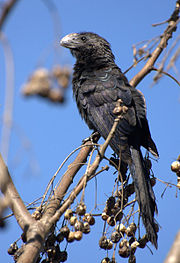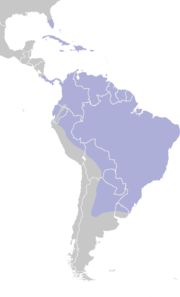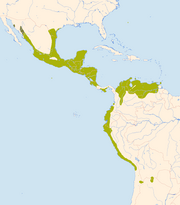
The four species of avocets are a genus, Recurvirostra, of waders in the same avian family as the stilts. The genus name comes from Latin recurvus, 'curved backwards' and rostrum, 'bill'. The common name is thought to derive from the Italian (Ferrarese) word avosetta. Francis Willughby in 1678 noted it as the "Avosetta of the Italians".
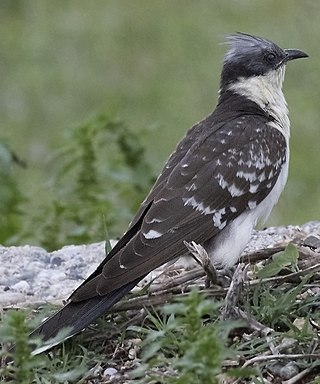
The great spotted cuckoo is a member of the cuckoo order of birds, the Cuculiformes, which also includes the roadrunners, the anis and the coucals.

The roseate spoonbill is a gregarious wading bird of the ibis and spoonbill family, Threskiornithidae. It is a resident breeder in both South and North America. The roseate spoonbill's pink color is diet-derived, consisting of the carotenoid pigment canthaxanthin, like the American flamingo.

The ferruginous pygmy owl is a small owl that breeds in south-central Arizona and southern Texas in the United States, south through Mexico and Central America, to South America into Brazil, Bolivia, Paraguay and Argentina.

The great black hawk is a bird of prey in the family Accipitridae, which also includes the eagles, hawks, and Old World vultures.

The blue-and-yellow macaw, also known as the blue-and-gold macaw, is a large Neotropical parrot with a mostly blue dorsum, light yellow/orange venter, and gradient hues of green on top of its head. It is a member of the large group of neotropical parrots known as macaws. It inhabits forest, woodland and savannah of tropical Central and South America, as well as the island of Trinidad in the Caribbean. They are popular in aviculture because of their striking color, ability to talk, ready availability in the marketplace, and close bonding to humans. It is the most commonly kept macaw species in captivity worldwide as a pet or companion parrot and is also the cheapest among the large macaws.

The blue-black grassquit is a small Neotropical bird in the tanager family, Thraupidae. It is the only member of the genus Volatinia. It is a common and widespread bird that breeds from southern Mexico through Central America, and South America as far as northern Chile, Argentina, and Paraguay, and in Trinidad and Tobago. A male was also observed in Graham County, Arizona on July 15 and July 17, 2023.

The rufous-breasted hermit or hairy hermit is a hummingbird that breeds from Panama south to Bolivia, and on Trinidad, Tobago and Grenada. It is a widespread and generally common species, though local populations may change in numbers and disappear altogether in marginal habitat.

The great tinamou is a species of tinamou ground bird native to Central and South America. There are several subspecies, mostly differentiated by their coloration.

The greater ani is a bird in the cuckoo family. It is sometimes referred to as the black cuckoo. It is found through tropical South America south to northern Argentina.

The smooth-billed ani is a bird in the cuckoo family. It is a resident breeding species from southern Florida, the Caribbean, parts of Central America, south to western Ecuador, Brazil, northern Argentina and southern Chile. It was introduced to Galápagos around the 1960s and is potentially impacting native and endemic species across the archipelago.

The guira cuckoo, known in Spanish as the pirincho is a species of gregarious bird found widely in open and semi-open habitats of northeastern, eastern and southern Brazil, Uruguay, Paraguay, Bolivia, and northeastern Argentina. It is the only species placed in the genus Guira.

Cuculus is a genus of cuckoos which has representatives in most of the Old World, although the greatest diversity is in tropical southern and southeastern Asia.

The Caatinga puffbird is a species of bird in the family Bucconidae, the puffbirds, nunlets, and nunbirds. It is endemic to Brazil.

Touit is a genus of Neotropical parrots in the family Psittacidae.

The São Tomé green pigeon is a species of bird in the family Columbidae. It is endemic to the island of São Tomé in São Tomé and Príncipe. Its natural habitat is subtropical or tropical moist lowland forests. The species was described by Johann Friedrich Gmelin in 1789. They have disappeared from Ilhéu das Rolas due to habitat loss. There are between 37,007-109,255 pigeons of this species today, but this is decreasing due to unsustainable levels of hunting.

The guira tanager is a species of bird in the family Thraupidae.

The sayaca tanager is a species of bird in the family Thraupidae, the tanagers. It is a common resident in northeastern, central, and southeastern Brazil, and Bolivia, Paraguay, Uruguay, and northeastern Argentina. A few are recorded from far southeastern Peru, but its status there is unclear, in part due to the potential of confusion with the very similar juveniles of the blue-grey tanager.
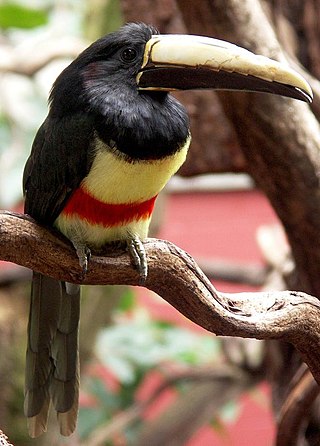
The black-necked aracari or black-necked araçari is a near-passerine bird in the toucan family Ramphastidae. It is found in Brazil, French Guiana, Guyana, Suriname, and Venezuela.
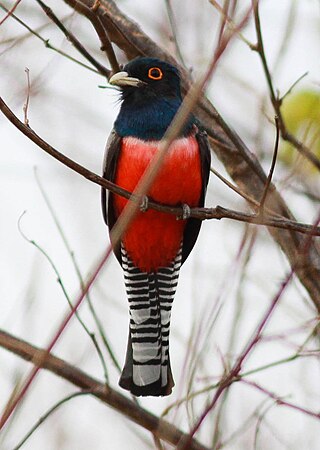
The blue-crowned trogon is a species of bird in the family Trogonidae, the quetzals and trogons. It is found in Brazil, Argentina, Bolivia, Colombia, Ecuador, Paraguay, and Peru. As with all trogons, this species is sexually dimorphic. The male has a blue head with an orange orbital ring, a red belly with a narrow white breastband and a green back. The female differs in having a grey head, a grey back and a broken white eye-ring.



